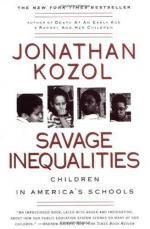
|
| Name: _________________________ | Period: ___________________ |
This test consists of 15 multiple choice questions and 5 short answer questions.
Multiple Choice Questions
1. What type of people does Octovia, a child at the Anacostia elementary school, say that the girls want to be like when they grow up?
(a) Lawyers.
(b) Secretaries.
(c) Rock stars.
(d) Teachers.
2. After speaking to the kindergarten class at PS79, Kozol learns that one of the African-American boys in the class travels how long each day to get to school?
(a) 4 hours.
(b) 3 hours.
(c) 1 hour.
(d) 2 hours.
3. At what age does the principal in Anacostia say many of the boys in her school will be dead?
(a) 25.
(b) 28.
(c) 21.
(d) 18.
4. Who said that Americans allow all of their children the things they need to compete at the highest levels of success?
(a) Langston Hughes.
(b) Martin Luther King.
(c) Queen Elizabeth.
(d) Lord Acton.
5. What racial group makes up 92 percent of the children that attend the public schools in Washington, D.C.?
(a) White.
(b) Hispanic.
(c) Asian.
(d) Black.
6. What issue do PS261 and PS79 share?
(a) Low enrollment.
(b) Unqualified teachers.
(c) Lack of up-to-date resources.
(d) Lack of space.
7. What is the only bright, clean building in the Camden area?
(a) The newest school.
(b) The whorehouse.
(c) The mall.
(d) The new prison.
8. What does the Wall Street Journal say has remained static while per-pupil spending has increased?
(a) Teacher retention rates.
(b) Student achievement.
(c) The dropout rate.
(d) Student attendance.
9. What does Kozol say Camden's entire property wealth of $250 million is less than the value of?
(a) One casino in Atlantic City.
(b) One upscale department store on New York City's Fifth Avenue.
(c) One school in the suburbs of Camden.
(d) One country club in Cherry Hill.
10. What does the principal of Tunisia's school say she sees children doing in order to have something to eat at home?
(a) Asking for extra food at lunch.
(b) Pocketing chicken nuggets.
(c) Stealing from other students lunches.
(d) Staying after school to receive free dinner.
11. According to the principal, how much does Woodrow Wilson spend yearly on each student?
(a) $4,000.
(b) $5,000.
(c) $3,000.
(d) $2,000.
12. What does Kozol say the high math and reading test scores in America are based on?
(a) How badly other schools are doing.
(b) How smart the students are.
(c) How well-prepared the students are.
(d) How much funding the schools receive.
13. What does the principal at PS79 say he will have to do if more students enroll at his school?
(a) He will have to bus them to another school.
(b) He will have to expand his classes.
(c) He will have to hold some classes in temporary trailers.
(d) He will have to find another building.
14. Where do most of the motivated children at Morris High School plan to go after they graduate?
(a) Technical school.
(b) Community college.
(c) To work.
(d) The military.
15. According to Kozol, students in what racial group are more often categorized with a speech disorder?
(a) White.
(b) Black.
(c) Hispanic.
(d) Asian.
Short Answer Questions
1. What state is Camden located in?
2. Why did the city of Chicago construct the high-speed Dan Ryan Expressway to go around certain parts of the city?
3. What was the former purpose of the building that houses PS261?
4. How many students attend Camden High School?
5. What reason do students give Kozol for dropping out of school in New York?
|
This section contains 578 words (approx. 2 pages at 300 words per page) |

|




